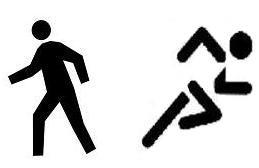 While you are trying to lose weight, any kind of exercise can be very beneficial. It can boost your metabolism, help you burn calories and can keep your momentum going to eat healthily. In addition, any form of exercise can improve your mood and help you sleep better — giving you many more benefits than just losing some inches on your waist!
While you are trying to lose weight, any kind of exercise can be very beneficial. It can boost your metabolism, help you burn calories and can keep your momentum going to eat healthily. In addition, any form of exercise can improve your mood and help you sleep better — giving you many more benefits than just losing some inches on your waist!
There are pros and cons to running and walking — but the important thing to remember is that either one is a great form of exercise and you should do what you enjoy the most. That way you have a much greater chance of keeping with it and staying active.
If you are unsure if running or walking is better for you, here are some tips that can help you make the best choice.
Compared to walking, running is a higher-intensity exercise and it will be easier for you to increase your heart rate quicker if you have limited time. Running also burns more calories than walking per mile. For example, for a 156 lb. person, running 1 mile burns 112.5 calories, and walking one mile runs 88.9 calories.
If you are walking at an extremely past face, about 12:30 minutes per mile, you will burn about the same as running.
Despite the caloric-burning benefits of running, it can be tougher on your body because of the high impact movement. With every stride you take there is some level of trauma to your knees and hips. So if you have any joint pain or past injuries, it’s a safer option to stick to running. However, running on a treadmill or on grass can minimize impact and help reduce joint pain.
If you are just starting to exercise or would like to stick to walking for whatever reason, a good tip is to wear a heart monitor during your walks. Find your target heart zone online and try to stay within that range to make sure you are getting enough out of it.
Also make sure you’re wearing a good pair of shoes, and ones that match your feet. (The three types of feet are flat feet, neutral feet and high arches.)
Whichever you choose, be proud of yourself for getting up and moving!
About the Author:
Jamie Eberle is the Chief Financial Officer of BeLiteWeight, which has helped over 6,500 patients have safe, affordable and successful weight loss surgery over the past 20 years. Jamie has had bariatric surgery and knows the ins and outs of the different procedures they run, including: vertical sleeve gastrectomy, gastric sleeve plication, Lap Band and gastric bypass surgery, among others. BeLiteWeight focuses on each patient’s needs to help them choose the right procedure and get started on the path to a healthier life.

